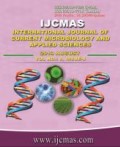


 National Academy of Agricultural Sciences (NAAS)
National Academy of Agricultural Sciences (NAAS)

|
PRINT ISSN : 2319-7692
Online ISSN : 2319-7706 Issues : 12 per year Publisher : Excellent Publishers Email : editorijcmas@gmail.com / submit@ijcmas.com Editor-in-chief: Dr.M.Prakash Index Copernicus ICV 2018: 95.39 NAAS RATING 2020: 5.38 |
In order to evaluate the effect of integrated nutrient management on periodic dry matter accumulation (DMA) and crop growth rate (CGR) of oat and lathyrus in various intercropping system, one field experiment was exercised at Central Research Farm, Gayeshpur, Bidhan Chandra Krishi Viswavidyalaya, Nadia, West Bengal during Rabi season of 2015-16 and 2016-17. The experiment was constructed in split plot design with 3 replications using4 levels of cropping system (CS1-Sole oat, CS2-Sole lathyrus, CS3 - Intercropping of oat with lathyrus in 3:2 row ratio andCS4- Intercropping of oat with lathyrus in 3:3 row ratio)in the main plot and 4 levels of nutrient management (N1 - Full RDF through inorganic source, N2 - 75% N through urea + rest N through FYM, N3 - 75% N through urea + rest N through vermicompost and N4 -75% N through urea + rest N through mustard oilcake) in the sub plot. Pooled results depicted that maximum DMA (287.58 g/m2, 175.96 g/m2 and 288.88 g/m2 of oat and 182.8 g/m2, 277.26 g/m2 and 334.39 g/m2of lathyrus) was observed at 60, 90 and 120 DAS under application of 75% N through urea + rest N through vermicompost in 3:3 intercropping system and in sole lathyrus respectively. Likewise, consequently CGR for both the crops followed the similar trend. Apart from sole cropping, further lathyrus under 3:3 intercropping system also showed high DMA and CGR at all periodic interval under application of 75% N through urea + rest N through vermicompost.
 |
 |
 |
 |
 |